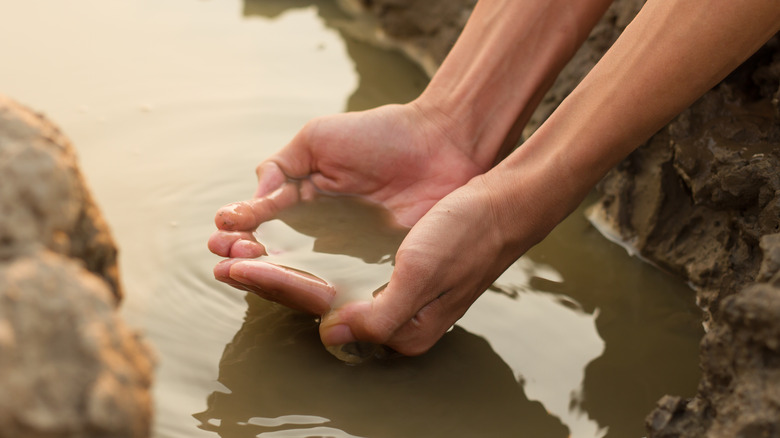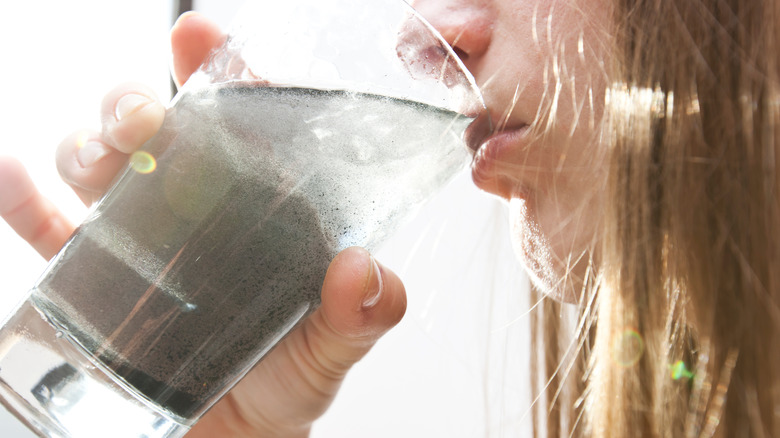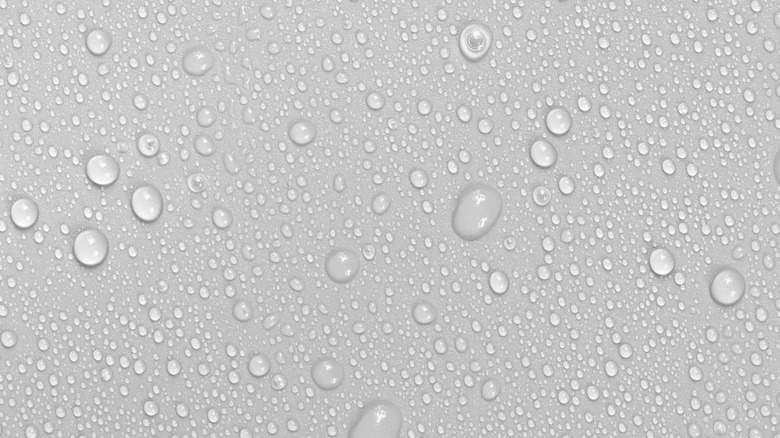What You Need To Know About Waterborne Diseases
During those hot summer months, finding ways to cool down can often involve jumping into a local swimming pool, lake, or river to get some refreshing relief from the sweltering heat. While most public pool facilities do actively treat water for parasites, bacteria, and other germs, naturally occurring bodies of water aren't typically treated. Additionally, some pathogens can make their way into treated water supplies through contact with animals, causing illness to those who are exposed to the contaminated water (per Nebraska Department of Health and Human Services).
While the United States Centers for Disease Control and Prevention (CDC) claims that America has some of the safest drinking water on the planet, they still report over 7 million individual cases of sickness related to waterborne illness and pathogens. So what are waterborne diseases? Lifewater defines waterborne diseases as illnesses that result from microscopic organisms living in bodies of water. These can include bacteria, viruses, and pathogens that contaminate water sources and supplies. However, illness and disease that results from chemicals and toxins found in water are not included in this definition (via CDC).
Where do waterborne diseases come from?
In some cases, according to one study, water sources become contaminated with disease-causing pathogens as a result of human and animal feces being introduced into the body of water. This can occur naturally in places where animals and humans share water resources. For example, when animals enter and defecate in or very near the water, parasites, viruses, and bacteria can easily contaminate the common water source. Other sources of potential contaminants can be from pollution, such as improper sewage and vegetation runoff.
Waterborne diseases can be contracted and transmitted by both animals and humans through ingestion, and sometimes through exposure to water which has been contaminated by the disease-causing pathogens. News Medical Life Sciences explains that using contaminated water for drinking, washing clothes, and preparing food can also transmit those microscopic organisms that lead to waterborne diseases. The Nebraska Department of Health and Human Services explains that transmission of these diseases may also occur from person to person, in addition to possible transmission through inhalation of contaminated water droplets.
Common domestic waterborne diseases
Surprisingly, there are a large number of pathogens that can live in aquatic environments when the conditions are ideal. In fact, the CDC explains that in a 2014 survey, 17 waterborne pathogens were identified as being the primary cause for more than 7 million cases of illness. While there are too many to list individually, there are several common waterborne illnesses and diseases that you may be familiar with.
Otitis externa, more commonly known as "swimmer's ear," is one of the leading waterborne illnesses found domestically, according to the report published by the CDC. It alone accounts for approximately 65% of the total number of cases of waterborne illness each year (via CDC). Norovirus, a virus that causes nausea, vomiting, and diarrhea, is second on the list, bearing responsibility for approximately 19% of cases. Giardiasis (or Giardia) is a parasite that causes diarrhea and is third on the list, accounting for 6%. Cryptosporidiosis is another microscopic parasite that causes intestinal distress and is responsible for approximately 5% of waterborne illnesses each year. And finally, coming in fifth place and accounting for the remaining 2% of infections is a bacterial infection called campylobacteriosis. While these illnesses pose some unpleasant side effects, they are not life-threatening and are easily treated.
Worldwide waterborne diseases
However, in other areas where access to clean water is extremely limited or non-existent, much more serious waterborne diseases threaten the life and ecosystems of those who rely on natural bodies of water for drinking, bathing, and hygiene purposes. Lifewater provides a list of the seven most common waterborne diseases worldwide, taking into account rural areas where access to water and purification options are not readily available. These include typhoid fever, dysentery, escherichia coli (E. coli), hepatitis A, cholera, giardia, and salmonella. Like the common illnesses we experience in the U.S., these waterborne diseases are most often contracted through ingestion of contaminated water. However, in some cases, as with cholera, infection can also be transmitted by touching the mouth or nose with unwashed hands that may have come into contact with fecal matter or contaminated water (via Lifewater). With most of these diseases, the symptoms will last for several hours to several days before the disease has run its course. However, diseases like cholera and dysentery can become life-threatening very quickly, particularly when clean drinking water is not accessible.
Tips for protecting against waterborne diseases
For those living in the United States, access to clean water and water purification options makes prevention of waterborne diseases much easier to manage. In fact, in America, a significant percentage of commonly transmitted waterborne illnesses come from recreational pools, lakes, and other bodies of water used for entertainment, according to PopSugar Fitness. Prevention in areas where such access is available can be done through conscientious actions and hygiene, such as practicing ensuring that you are washing your hands properly (per Lifewater). Also choosing well-maintained aquatic recreational facilities and avoiding ingestion of recreational bodies of water are just a few ways you can avoid exposure to waterborne illnesses (via PopSugar Fitness).
Other suggestions include avoiding defecation or urination in recreational water sources, like public pools (via Nebraska Department of Health and Human Services). While a seemingly obvious recommendation, this also includes ensuring that children who are not potty-trained are wearing appropriate swim diapers and are frequently changed. Another recommendation is to avoid recreational or public water sources when you are experiencing symptoms like diarrhea.
The takeaway
The world is full of organisms, big and small, each having a positive, negative, or neutral interaction on the organisms in a shared environment. Bodies of water, particularly those that are naturally occurring or those that go untreated properly, provide a perfect atmosphere for harboring some pretty gnarly bacteria, viruses, and pathogens that can create mild to extreme intestinal and physical distress to human beings (via PopSugar Fitness).
While access to clean water is not readily available in all areas, resources and organizations are working diligently to provide water purification solutions to those in need (via Lifewater). In addition to consuming clean or purified water, prevention of waterborne illnesses can occur by reducing your exposure to unhygienic water and practicing safe hygiene, like regular hand washing.
If you have come into contact with a contaminated water source, or believe that you may have contracted a waterborne disease, monitor your symptoms and follow up with your doctor for appropriate care.






